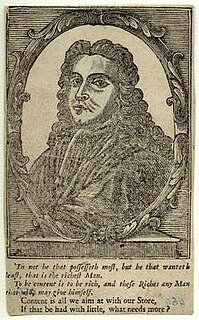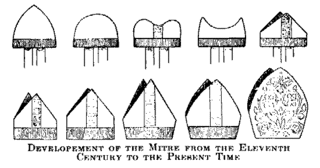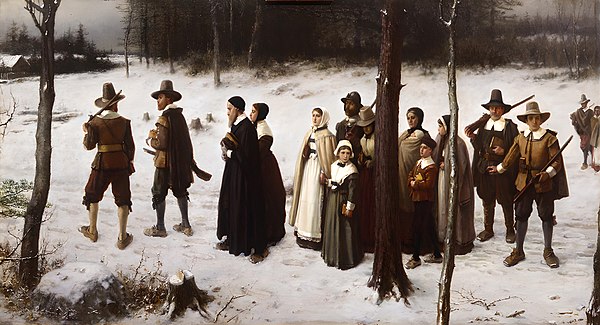
The Thirteen Colonies, also known as the Thirteen British Colonies or the Thirteen American Colonies, were a group of colonies of Great Britain on the Atlantic coast of America founded in the 17th and 18th centuries which declared independence in 1776 and formed the United States of America. The Thirteen Colonies had very similar political, constitutional, and legal systems and were dominated by Protestant English-speakers. They were part of Britain's possessions in the New World, which also included colonies in Canada, Florida, and the Caribbean.

John Winthrop was an English Puritan lawyer and one of the leading figures in founding the Massachusetts Bay Colony, the second major settlement in New England, following Plymouth Colony. Winthrop led the first large wave of immigrants from England in 1630 and served as governor for 12 of the colony's first 20 years. His writings and vision of the colony as a Puritan "city upon a hill" dominated New England colonial development, influencing the governments and religions of neighboring colonies.

John Cotton was a clergyman in England and the American colonies and considered the preeminent minister and theologian of the Massachusetts Bay Colony. He studied for five years at Trinity College, Cambridge and another nine at Emmanuel College, Cambridge. He had already built a reputation as a scholar and outstanding preacher when he accepted the position of minister at St. Botolph's Church, Boston in Lincolnshire in 1612. As a Puritan, he wanted to do away with the ceremony and vestments associated with the established Church of England and preach in a simpler manner. He felt that the English church needed significant reforms, but he was adamant about not separating from it; his preference was to change it from within.
Francis Higginson was an early Puritan minister in Colonial New England, and the first minister of Salem, Massachusetts.

John Coggeshall Sr. was one of the founders of the Colony of Rhode Island and Providence Plantations and the first President of all four towns in the Colony. He was a successful silk merchant in Essex, England, but he emigrated to the Massachusetts Bay Colony in 1632 and quickly assumed a number of roles in the colonial government. In the mid-1630s, he became a supporter of dissident minister John Wheelwright and of Anne Hutchinson. Hutchinson was tried as a heretic in 1637, and Coggeshall was one of three deputies who voted for her acquittal. She was banished from the colony in 1638, and the three deputies who voted for her acquittal were also compelled to leave. Before leaving Boston, Coggeshall and many other Hutchinson supporters signed the Portsmouth Compact in March 1638 agreeing to form a government based on the individual consent of the inhabitants. They then established the settlement of Portsmouth on Aquidneck Island, one of the four towns comprising the Colony of Rhode Island and Providence Plantations.
Captain Thomas Wiggin (1601-1666)), often known as Governor Thomas Wiggin, was the first governor of the Upper Plantation of New Hampshire, a settlement that later became part of the Province of New Hampshire in 1679. He was the founder of Stratham, Rockingham, New Hampshire, which celebrated its 300th anniversary of incorporation in 2016. The son of a vicar in the Church of England with family ties to important and influential families of the era. A highly respected man in his own right who would leave his stamp on what would become American values.
John Sanford was an early settler of Boston, Massachusetts, an original settler of Portsmouth, Rhode Island, and a governor of the combined towns of Portsmouth and Newport in the Rhode Island colony, dying in office after serving for less than a full term. He had some military experience in England, and also was an employee of Massachusetts magistrate John Winthrop's household prior to sailing to New England in 1631 with Winthrop's wife and oldest son. He lived in Boston for six years and was the cannoneer there.
The Great Migration Study Project is an ongoing scholarly endeavor to create short biographical sketches of all immigrants from Europe to colonial New England between 1620 and 1640. These number over 5,000 individuals, not including dependent wives and children, almost all of whom came from England. Directed by Robert Charles Anderson, the project is conducted in collaboration with the New England Historic Genealogical Society and has been underway since 1988.
The New England Colonies of British America included Connecticut Colony, the Colony of Rhode Island and Providence Plantations, Massachusetts Bay Colony, and the Province of New Hampshire, as well as a few smaller short-lived colonies. The New England colonies were part of the Thirteen Colonies and eventually became five of the six states in New England. Captain John Smith's 1616 work A Description of New England first applied the term "New England" to the coastal lands from Long Island Sound to Newfoundland.

John White was the rector of a parish in Dorchester, Dorset, England. He was instrumental in obtaining charters for the New England Company, and the Massachusetts Bay Company. He took a close personal interest in the settlement of New England.
The Revd Isaac Johnson, a 17th-century English clergyman, was one of the Puritan founders of Massachusetts and the colony's First Magistrate.
Matthew Cradock was a London merchant, politician, and the first governor of the Massachusetts Bay Company. Founded in 1628, it was an organization of Puritan businessmen that organized and established the Massachusetts Bay Colony. Although he never visited the colony, Cradock owned property and businesses there, and he acted on its behalf in London. His business and trading empire encompassed at least 18 ships, and extended from the West Indies and North America to Europe and the Near East. He was a dominant figure in the tobacco trade.
The Old Planters of Massachusetts were settlers of lands on Massachusetts Bay that were not part of the two major settlements in the area, the Plymouth Colony (1620), and the Massachusetts Bay Colony.

In the early 17th century, thousands of English Puritans colonized North America, mainly in New England. Puritans were generally members of the Church of England who believed that the Church of England was insufficiently reformed, retaining too much of its Roman Catholic doctrinal roots, and who therefore opposed royal ecclesiastical policy under Elizabeth I of England, James I of England, and Charles I of England. Most Puritans were "non-separating Puritans", meaning that they did not advocate setting up separate congregations distinct from the Church of England; a small minority of Puritans were "separating Puritans" who advocated setting up congregations outside the Church. The Pilgrims were a Separatist group, and they established the Plymouth Colony in 1620. Non-separating Puritans played leading roles in establishing the Massachusetts Bay Colony in 1629, the Saybrook Colony in 1635, the Connecticut Colony in 1636, and the New Haven Colony in 1638. The Colony of Rhode Island and Providence Plantations was established by settlers expelled from the Massachusetts Bay Colony because of their unorthodox religious opinions. Puritans were also active in New Hampshire before it became a crown colony in 1691.
Samuel Skelton was the first pastor of the First Church of Salem, Massachusetts, which is the original Puritan church in North America.
William Vassall was an English settler in North America. He was from the educated gentry, and a supporter of freedom of religion. In March 1629 he was recorded in the Charter for the Massachusetts Bay Company as a patentee, along with his brother Samuel.
John Humphrey was an English Puritan and an early funder of the English colonisation of North America. He was the treasurer of the Dorchester Company, which established an unsuccessful settlement on Massachusetts Bay in the 1620s, and was deputy governor of the Massachusetts Bay Company from 1629 to 1630. He came to Massachusetts in 1634, where he served as a magistrate and was the first sergeant major general of the Ancient and Honorable Artillery Company. He became involved in English attempts to settle Providencia Island in the late 1630s, and returned to England in 1641 after financial reverses and probable religious differences with other members of the Massachusetts ruling elite. He then became involved in an attempt to settle The Bahamas in the late 1640s, and had some involvement in the politics of the English Civil War.

The Antinomian Controversy, also known as the Free Grace Controversy, was a religious and political conflict in the Massachusetts Bay Colony from 1636 to 1638. It pitted most of the colony's ministers and magistrates against some adherents of the Free Grace theology of Puritan minister John Cotton. The most notable Free Grace advocates, often called "Antinomians", were charismatic Anne Hutchinson, her brother-in-law Reverend John Wheelwright, and Massachusetts Bay Governor Henry Vane. The controversy was a theological debate concerning the "covenant of grace" and "covenant of works".
















